Scandinavian kitchens are prized for their blend of function, neutral colors, minimalist (“less-is-more”) style, and warm wood accents, often with unique details.
These kitchens draw on the clean lines and craftsmanship of midcentury design, principles that still influence modern interiors.
Today, the adaptable Scandi style, frequently mixed with other aesthetics, is a global favorite.
Browse these diverse examples—from minimalist city apartments to rustic Swedish farmhouses—for inspiration on bringing cool Nordic design into your own kitchen.
Brighten your Scandinavian kitchen with white
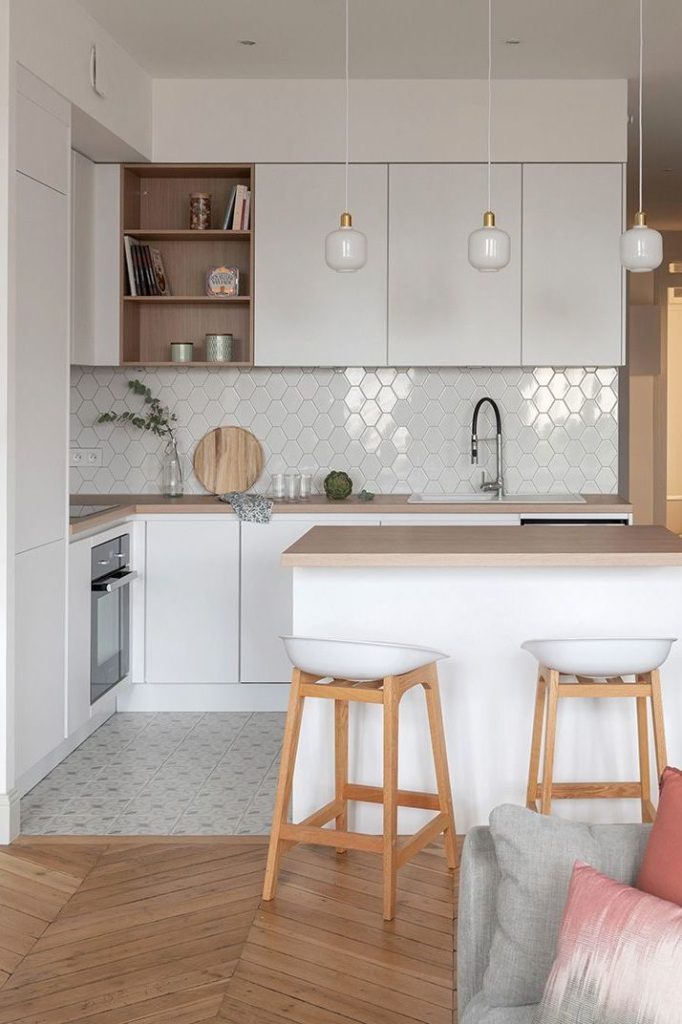
Give your Scandinavian kitchen a fresh and modern touch by using white accents.
From painting the walls in a light hue to adding white touches to cabinets, tea towels, or other accessories, you can create an open, inviting space that’s filled with natural light and warmth.
If you want to further enhance the look, consider selecting pieces of furniture with unique designs that blend into the background.
Whether it be sleek lines or artistic curves on chairs and tables, any extra touches can help personalize the space and make it feel like home.
White and Gray Scandinavian Style Kitchen
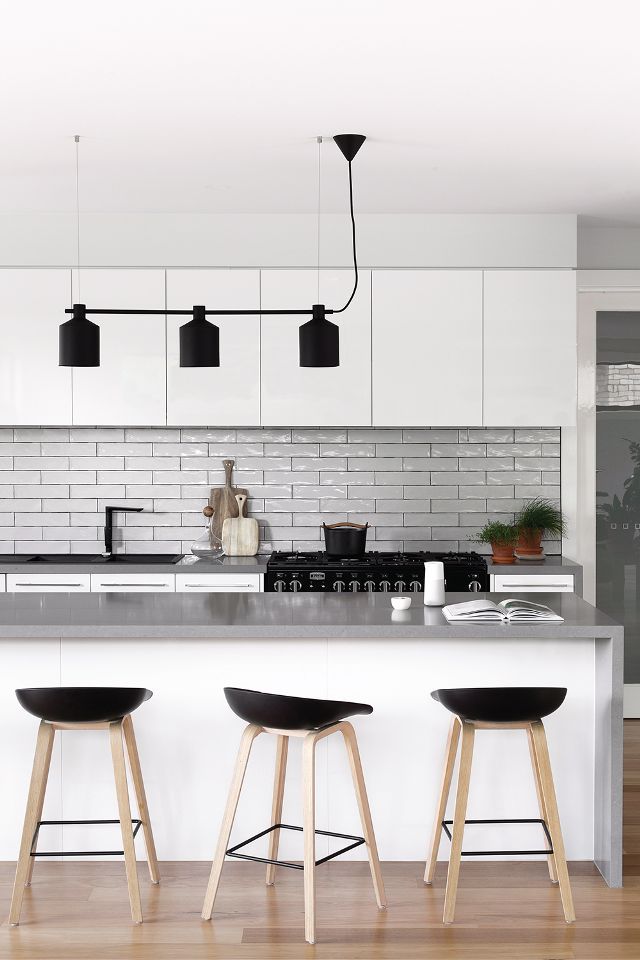
Welcome to the white and gray Scandinavian kitchen, where minimalism meets classic design.
This unique space offers a modern twist on traditional Scandi-style aesthetics.
With its clean lines and light shades of white and gray, it exudes an airy feel that will make you instantly feel at home.
From subtle touches like floating shelves and soft lighting fixtures to bolder elements such as statement counters, this kitchen will bring out the best in your style!
Scandinavian Blue Cabinets
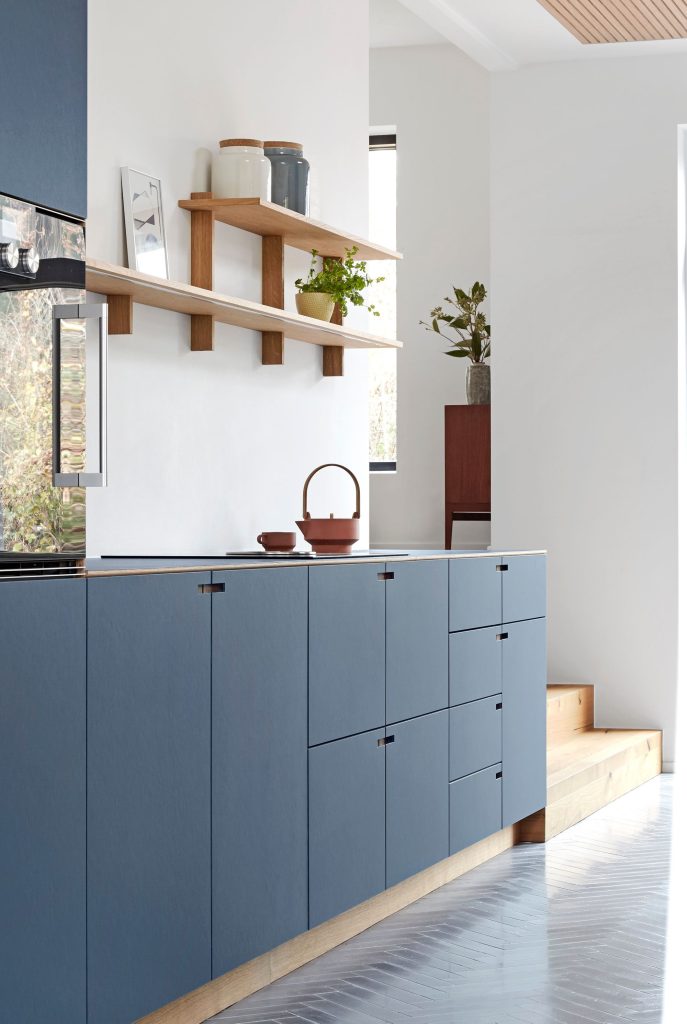
Adding a touch of Scandinavian style to your kitchen is easy with a set of blue cabinets.
Whether you choose deep navy or softer pastel shades, the cool tones will give your kitchen an elegant and modern look.
You can mix and match shades and materials with wooden countertops, square white tile backsplash, or stainless steel accents for a unique Scandinavian design.
With some simple alterations like adding gold hardware or swapping out knobs, you’ll be sure to create a dreamy yet functional space that brings out the best in your home.
Maximize Natural Light
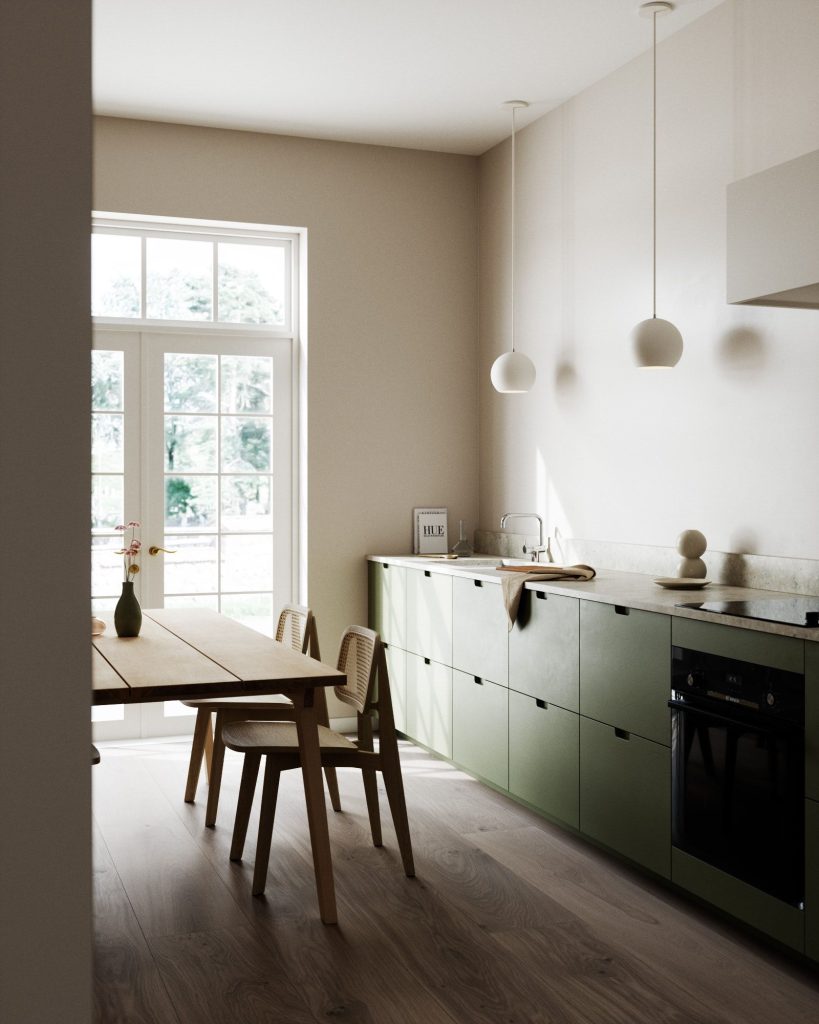
Natural light helps brighten up any room – including the Scandinavian kitchen!
To get the most out of natural light sources, install large windows or glass doors that let sunlight pour into your cooking area during the day.
This will not only keep your space feeling spacious but also help save energy costs by eliminating the need for electric lights during daylight hours!
Prioritize Function
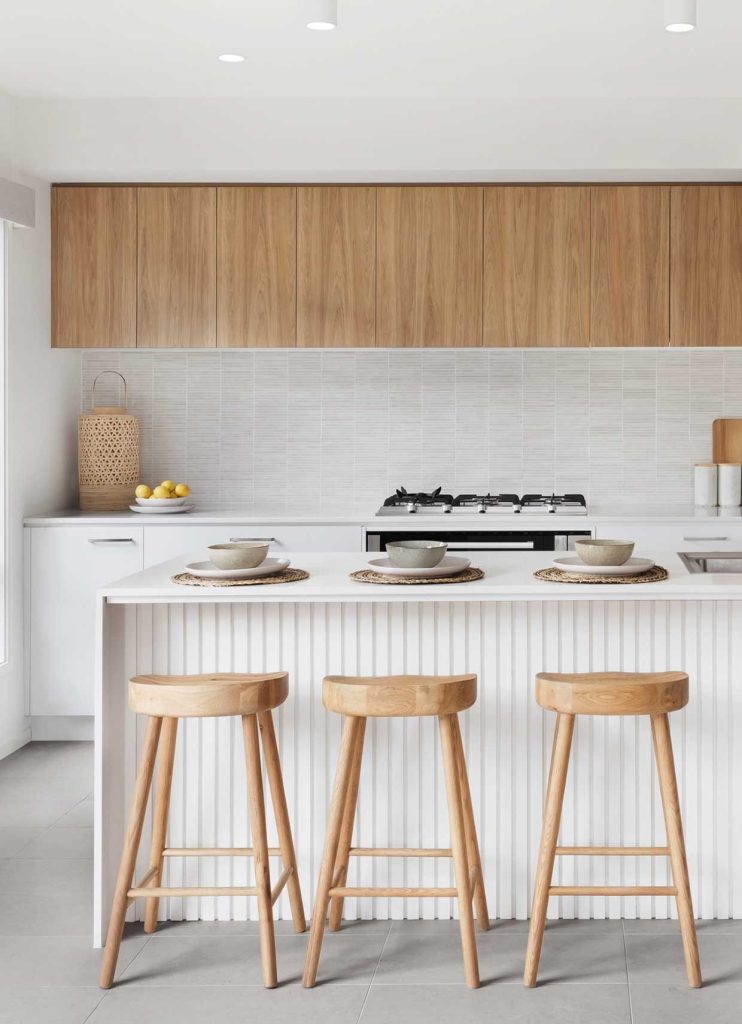
Scandi kitchens are renowned for their use of innovative and functional design.
Regardless of the size of the kitchen, its focus is always on the efficient use of space and functionality.
In Scandi-style kitchens, form follows function with minimal embellishments.
From built-in storage to adjustable shelving, Scandinavian kitchens maximize utility in a modern way.
Bring nature inside with botanical wallpaper
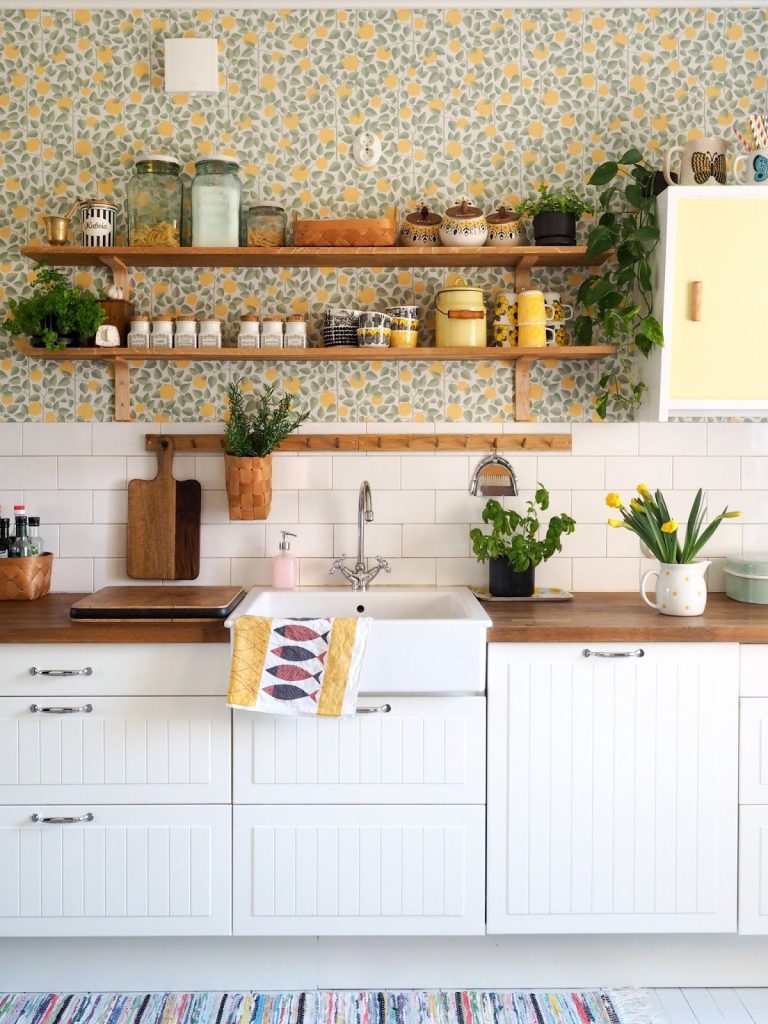
Bring the beauty of the outdoors into your kitchen with botanical wallpaper!
Not only will it add a fresh and serene look, but you’ll also feel like you’re in an oasis.
Plus, it’s easier to clean than paint walls. Get creative and go for something unique – like a tropical print or a foliage pattern.
You can even mix and match different colors and designs to create something special.
So, why not bring nature inside with botanical wallpaper? You won’t regret it!
Wood Table Kitchen Island
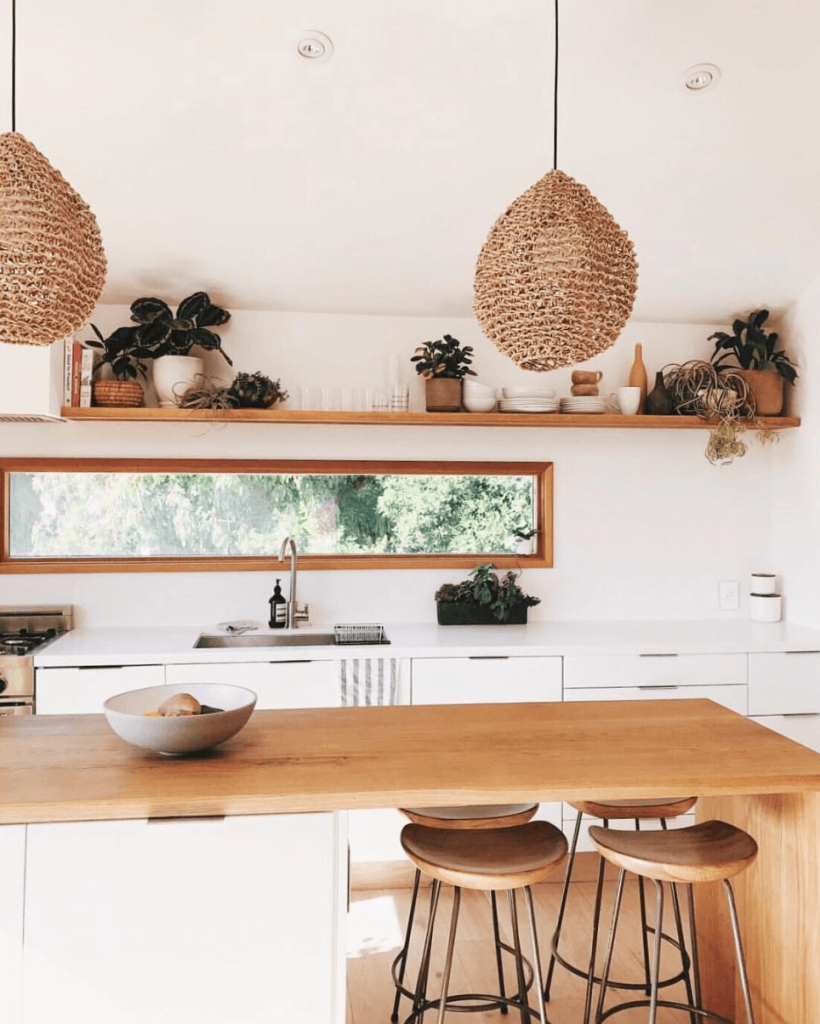
Transform your kitchen into a cozy Scandinavian-inspired oasis with a beautiful wood table island!
This stylish and functional piece can be the perfect centerpiece to bring the Scandi look to your home.
With its soft curves, warm wood tones, and minimalist design, this piece is sure to add character and charm to any kitchen.
You can add bar stools around the island and create a cozy breakfast bar in your kitchen.
With so many options available, you are sure to find the perfect one for your space.
Get creative and make your Scandi-style kitchen complete with a wood table island today!
Minimize Upper Cabinetry

Are you ready to make a statement in your kitchen design with minimal upper cabinetry?
If you are looking for a Scandi-style look with clean lines, consider using fewer cabinets above the sink or counter.
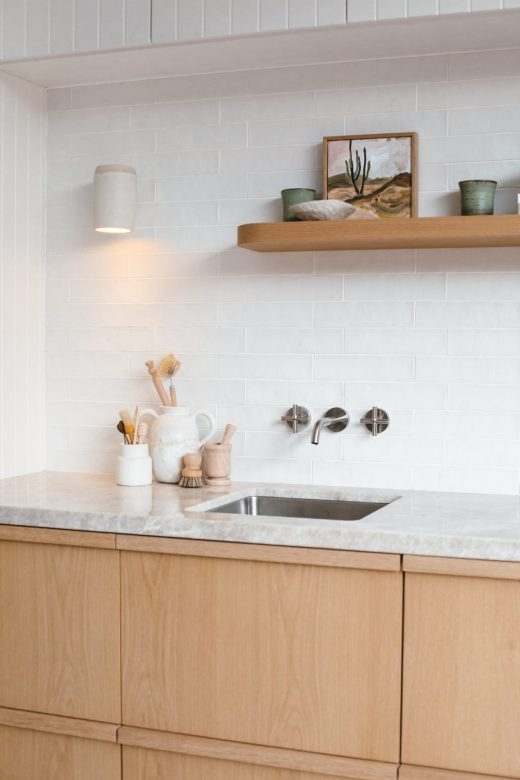
Opting for fewer cabinets can help to open up the space and create an airy feel.
Utilize shelving instead of upper cabinetry when possible; this will allow you to showcase beautiful items that add texture to the design.
Try experimenting with different types of materials such as wood and glass for an updated take on the traditional Scandi look.
Invest in good kitchen lighting
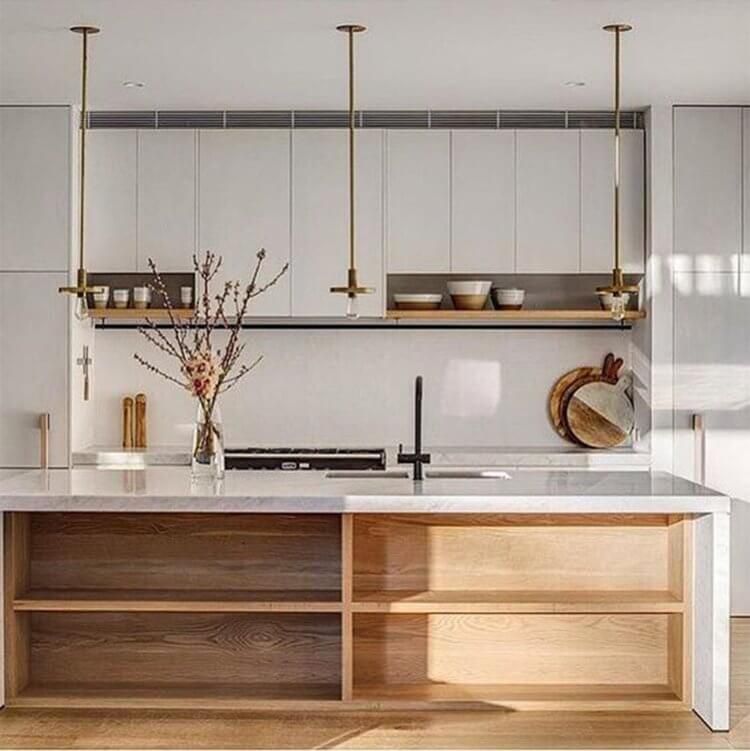
A good Scandinavian kitchen lighting system is essential for cooking and meal prep, not to mention setting the mood in the room.
From state-of-the-art modern solutions to classic designs that capture the essence of traditional kitchens, there are plenty of options available.
Investing in a reliable and stylish lighting system can help you transform your Scandinavian kitchen into an inviting space where family and friends will feel welcomed.
With careful planning and consideration, you’ll be able to find the right lighting setup that meets both your aesthetic and functional requirements.
Celebrate Natural Wood Tones
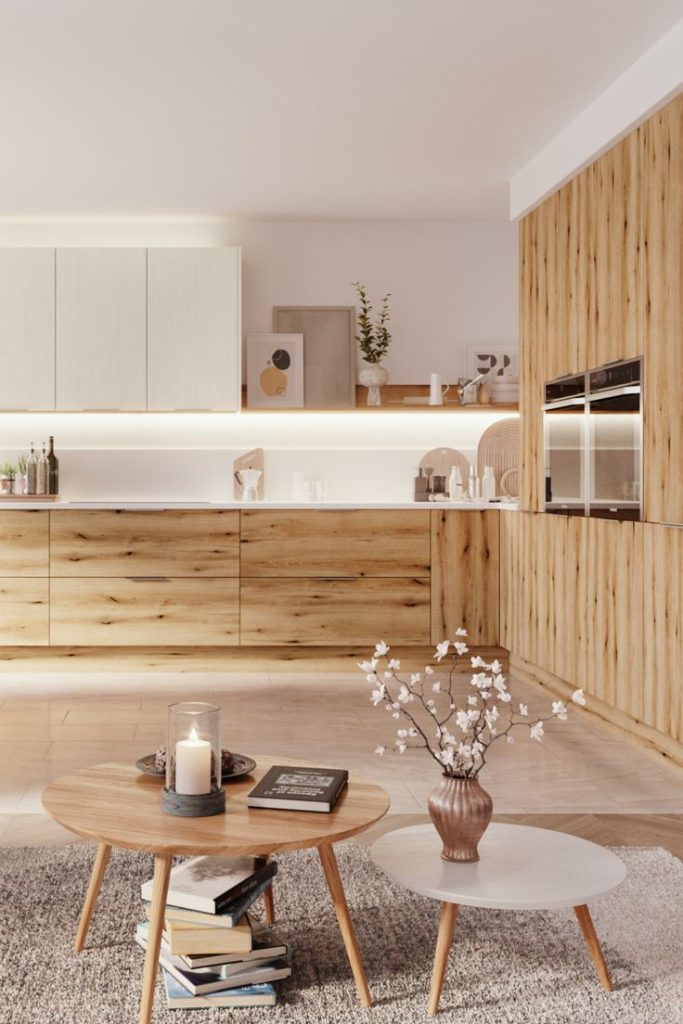
Natural wood tones are a great way to bring a Scandi-style kitchen to life.
They offer warmth and texture that can’t be achieved with other materials, making them perfect for a cozy atmosphere.
Plus, the great thing about wood tones is that they add character and charm to any space.
With the right furnishings and accessories, you can create an inviting and beautiful Scandi-style kitchen that your friends and family will enjoy gathering in for years to come!
Celebrate Natural Wood Tones
This modern Scandinavian kitchen from Fantastic Frank has flat-front cabinetry with barely there hardware that keeps the focus on the warm-toned floor-to-ceiling wood, while a cool aluminum backsplash adds contrast and reflects light.
Kelly green chairs around the pale wood round kitchen table break up all the natural wood colors and add energy to the design.
Embrace an All-White Palette
:max_bytes(150000):strip_icc():format(webp)/13SM-4617-0d990ccb7b204325b095e4ea920bd2c0.jpg) Design by Sissy + Marley Interiors / Photo by Marco Ricca
Design by Sissy + Marley Interiors / Photo by Marco Ricca
This airy kitchen from NYC-based Sissy + Marley Interiors has a clean, modern feel with all-white cabinetry and light oak flooring, and Scandi-style spindle-back painted wood bar stools and a trio of pendant lights with a Danish modern bent.
Minimize Upper Cabinetry
:max_bytes(150000):strip_icc():format(webp)/5.TheRealShakerKitchen-deVOL_LOW-RES-c57f3a455d3145fa9c117889f06c6c7c.jpg) Design and Photo by deVOL Kitchens
Design and Photo by deVOL Kitchens
This serene kitchen from UK-based deVOL Kitchens uses classic English Shaker-style cabinetry to create a Scandi-style oasis in shades of taupe and white.
A side wall features ample storage and glass-front cabinetry, allowing the back wall above the sink to remain free and clear to contribute to the calming, Scandi-style aesthetic.
Add Industrial Farmhouse Elements
:max_bytes(150000):strip_icc():format(webp)/2.-Flatiron-Apartment-by-Chango--Co.---Kitchen-Island-and-Range-bad6f4745484402182cfbf3535301b88.jpg) Design by Chango & Co. / Photo by Jacob Snavely
Design by Chango & Co. / Photo by Jacob Snavely
This spacious Flatiron kitchen from NYC-based Chango & Co. combines industrial, modern farmhouse, and Scandi-style elements, with its stainless steel appliances, white subway tile backsplash, white Shaker-style cabinetry, and custom-built island stained in a rich dark wood tone.
Blend with Classic French Style
:max_bytes(150000):strip_icc():format(webp)/2D3A0796b-min-scaled-2000x1334-e6ec9a96c776427895a87542710aded1-a2c1021765824bcb89fcb5e8c62d12d4.jpg) Design by Leymarie Gourdon Architectes / Photo by BCDF Studio
Design by Leymarie Gourdon Architectes / Photo by BCDF Studio
Scandi style is wildly popular in France, where many interiors marry classic French architecture with Scandi style decor to create a pleasing contemporary mix that celebrates both styles.
This Parisian kitchen from Chloé Leymarie and Eva Gourdon of Leymarie Gourdon Architectes has elegant French bones and intricate historic ceiling moldings that are contrasted beautifully with minimalist warm wood cabinetry and a restrained Scandi-style aesthetic that brings the period room into the 21st century.
Prioritize Function
:max_bytes(150000):strip_icc():format(webp)/SFinteriors-09-51ca273f69924aeaa063a447d64b6833.jpg) Design by Cathie Hong Interiors / Photo by Christy Q. Photo
Design by Cathie Hong Interiors / Photo by Christy Q. Photo
This California kitchen from Cathie Hong Interiors has a simple palette of white, black, and silver, a functional layout, and warm wood accents throughout that keep it feeling homey and warm.
Pale oak flooring reinforces the Scandi-style aesthetic.
Add Sculptural Accents
This slick contemporary Scandinavian kitchen from Fantastic Frank has a wall of white cabinetry, silver appliances, a shiny marble dining table in place of a kitchen island, and black accents from the countertops to lighting to chairs.
Highlight Midcentury Classics
:max_bytes(150000):strip_icc():format(webp)/JoshuaSmithIncphotocredLanceGerber-165bd08b1a434877bfebae6cf9da7051.jpeg) Design by Joshua Smith Inc. / Photo by Lance Gerber
Design by Joshua Smith Inc. / Photo by Lance Gerber
A Scandi-inspired modern kitchen and dining area from Joshua Smith Inc. features soft white walls and sculptural midcentury bentwood chairs and wishbone bar stools.
Add Black Accents
:max_bytes(150000):strip_icc():format(webp)/07.SouthamptonVillagebyChangoCo.-Kitchen-dd15b57b8754469da47ef166abc6434b.jpg) Design by Chango & Co. / Photo by Christian Torres
Design by Chango & Co. / Photo by Christian Torres
This Southampton, New York kitchen from Chango & Co. has a polished, clean aesthetic that blends American modern farmhouse with Scandi-style accents like the black painted wood bar stools and black metal pendant lighting.
Maximize Natural Light
This white-washed, light-flooded Scandinavian eat-in kitchen from Fantastic Frank has pale painted floors and simple midcentury furnishings like Eames Eiffel chairs and a Danish modern pendant light hanging over the tulip-style table.
Add a Touch of Bling
:max_bytes(150000):strip_icc():format(webp)/LindyeGallowayStudioShop_Credit_ChadMellon_101-33c501fc735d4e329429ea54dd1acc31.jpeg) Design by Lindye Galloway Studio + Shop / Photo by Chad Mellon
Design by Lindye Galloway Studio + Shop / Photo by Chad Mellon
This glossy take on Scandi style from Costa Mesa, California-based Lindye Galloway Studio + Shop has a mix of warm toned wood and pale marble effect quartz countertops and gleaming white backsplash tiling.
Double islands and touches of gold add some American-style bling, but the Scandi-style pendant lighting is a callback to the source.
Use Flat-Front Cabinetry
This Copenhagen kitchen from Fantastic Frank has a contemporary Scandinavian feel with its streamlined layout and minimalist white flat-front cabinetry.
Here, the kitchen island has a lip on one short end that accommodates bar seating for two, leaving the long side unencumbered by bar stools and full of under-island storage that helps maintain an uncluttered look.
A nearby dining table in the open plan room accommodates sit-down meals for friends and family.
Add Warm Wood Touches
:max_bytes(150000):strip_icc():format(webp)/Scandi_Kitchen_Jessie_Tobias_Design_Photo_by_Sarah_Szwajkos_02-f8fef099dc1242079c947cfb276fb4d8.jpeg) Design by Jessie Tobias Design / Photo by Sarah Szwajkos
Design by Jessie Tobias Design / Photo by Sarah Szwajkos
This homey L-shaped kitchen from Camden, Maine-based Jessie Tobias Design has floor-to-ceiling built-in cabinetry accented with black hardware.
With simple glass bulb pendant lighting, and warm wood detailing from the ceiling to the oven vent to the bar stools and flooring, it’s a warm American take on Scandi style.
Mix Metals
:max_bytes(150000):strip_icc():format(webp)/cathiehong-9190-ba6e9485e50c4da88972cff62f044ba7.jpg) Design by Cathie Hong Interiors / Photo by Amber Thrane
Design by Cathie Hong Interiors / Photo by Amber Thrane
This California galley-style kitchen from Cathie Hong Interiors takes a minimalist Scandi-inspired approach with a black, white, and gray palette, minimal upper cabinetry, and adds mixed metal finished to keep it from looking too stark.
Add a Whisper of Color
This Scandinavian kitchen from Fantastic Frank includes plenty of negative space thanks to ceiling-scraping cabinetry that leaves room for a swath of blank wall, giving the design a chance to breathe.
Pale pistachio green paint adds relief from all the white while acting as a neutral.
A single acid yellow chair at the adjacent dining table adds a shot of color that wakes up the quiet design, showing that it doesn’t take itself too seriously.
Incorporate Vintage Touches
:max_bytes(150000):strip_icc():format(webp)/C5C1F37E-19C6-4A8A-AA68-92717E1166E8-scaled-9a1bcda109fb4fbeb3b885868a523437.jpeg) Design by Brexton Cole Interiors
Design by Brexton Cole Interiors
This kitchen from Brexton Cole Interiors takes a page out of the Scandi playbook with acres of clear countertops, a white tile backsplash that reaches to the ceiling, a simple black-and-white color scheme, and touches of vintage art and decor to add a sense of timelessness.
Keep a Low Profile
:max_bytes(150000):strip_icc():format(webp)/Scandi_Kitchen_HousesCottages_Photo_by_Sarah_Szwajkos_03-5ad13ef6beb14b94bafdb6581f10352b.jpeg) Photo by Sarah Szwajkos
Photo by Sarah Szwajkos
Losing upper cabinetry is one way to streamline your kitchen design and create a serene Scandi-inspired feel, like this light and airy kitchen with white walls, warm wood cabinetry, and a central island defined by pendant lights outfitted with shades to produce diffused warm light.


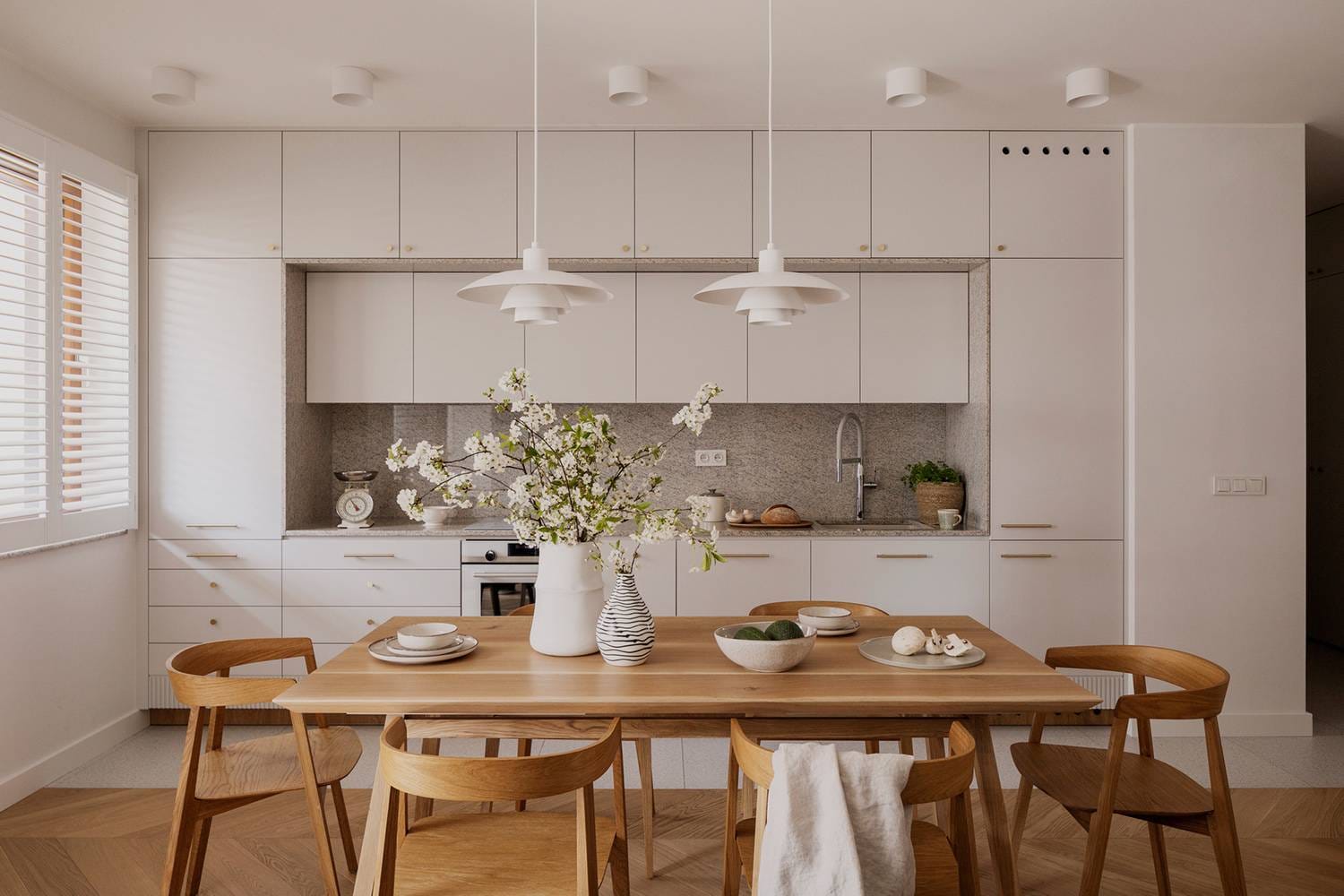
:max_bytes(150000):strip_icc():format(webp)/Radmansgatan-6eee9f9fb3e248a0a6bd43748a615985.jpg)
:max_bytes(150000):strip_icc():format(webp)/MEDBCD21271CE064E29AB4116CC86F94A14-e05442095517432eb9738ed9d37d1095.jpg)
:max_bytes(150000):strip_icc():format(webp)/MEDEEE900C5DBC248F49F6F9C7A0AE7CF5C-442c21bf28764264a4723627c7dba9a4.jpg)
:max_bytes(150000):strip_icc():format(webp)/get-148ef08de5134693babae015ece33561.jpg)
:max_bytes(150000):strip_icc():format(webp)/GastrikegatanJHa-15ded296174c428aade175ccb9aece01.jpg)